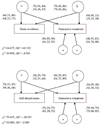Temperament and character associated with depressive symptoms in women: analysis of two genetically informative samples
- PMID: 19455609
- PMCID: PMC3025404
- DOI: 10.1002/jclp.20587
Temperament and character associated with depressive symptoms in women: analysis of two genetically informative samples
Abstract
Although previous research has explored associations between personality and depressive symptoms, a limited number of studies have assessed the extent to which genetic and environmental influences explain the association. This study investigated how temperament and character were associated with depressive symptoms in 131 pairs of twin and sibling women in early adulthood, as well as 326 pairs of twin women in middle adulthood. Results indicated that genetic influences accounted for a moderate to substantial percentage of the association between these personality features and depressive symptoms, emphasizing the role of genetic influences. Nonshared environmental influences made important contributions to the association between character and depressive symptoms, particularly in the sample of middle-aged twin women. These findings suggest that unique social experiences and relationships with a partner in adulthood may play an important role in these associations between character and depressive symptoms.
Figures



Similar articles
-
The role of temperament and social support in depressive symptoms: a twin study of mid-aged women.J Affect Disord. 2008 Feb;106(1-2):99-105. doi: 10.1016/j.jad.2007.05.025. Epub 2007 Jul 3. J Affect Disord. 2008. PMID: 17610958
-
Some personality traits converge gradually by long-term partnership through the lifecourse--genetic and environmental structure of Cloninger's temperament and character dimensions.J Psychiatr Res. 2015 Apr;63:43-9. doi: 10.1016/j.jpsychires.2015.01.020. Epub 2015 Feb 24. J Psychiatr Res. 2015. PMID: 25748752
-
Psychological but not vasomotor symptoms are associated with temperament and character traits.Climacteric. 2014 Aug;17(4):500-9. doi: 10.3109/13697137.2014.890180. Epub 2014 Mar 8. Climacteric. 2014. PMID: 24606596
-
[Personality factors in depressive disorders: contribution of the psychobiologic model developed by Cloninger].Encephale. 2002 Jul-Aug;28(4):363-73. Encephale. 2002. PMID: 12232546 Review. French.
-
The role of temperament and character in the anxiety-depression spectrum among Korean adults.J Affect Disord. 2024 Aug 15;359:1-13. doi: 10.1016/j.jad.2024.05.052. Epub 2024 May 17. J Affect Disord. 2024. PMID: 38759504 Review.
Cited by
-
Did I Inherit My Moral Compass? Examining Socialization and Evocative Mechanisms for Virtuous Character Development.Behav Genet. 2019 Mar;49(2):175-186. doi: 10.1007/s10519-018-09945-4. Epub 2019 Jan 17. Behav Genet. 2019. PMID: 30656439 Free PMC article.
References
-
- Akaike H. Factor analysis and AIC. Psychometrika. 1987;52:317–332.
-
- Ando J, Ono Y, Yoshimura K, Onoda N, Shinohara M, Kanba S, Asai M. The genetic structure of Cloninger’s seven-factor model of temperament and character in a Japanese sample. Journal of Personality. 2002;70:583–609. - PubMed
-
- Blatt SJ. Experiences of depression: Theoretical, clinical, and research perspectives. Washington, DC: American Psychological Association; 2004.
-
- Blatt SJ, Quinlan DM, Chevron ES, McDonald C, Zuroff DC. Dependency and self-criticism. Journal of Consulting and Clinical Psychology. 1982;50:113–124. - PubMed
Publication types
MeSH terms
Grants and funding
LinkOut - more resources
Full Text Sources
Medical

